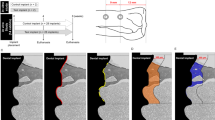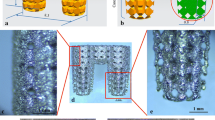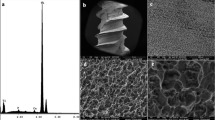Cylindrical implants, made of a dense yttria-partially-stabilized zirconia/hydroxyapatite composite and a dense pure hydroxyapatite ceramic, were implanted in the mandibular bone of two beagles and the femurs of eight rabbits. Some of the cylindrical implant surfaces were drilled with a laser beam to create 200×200 μm2 dimples. The bone ingrowth and the effect of bone in the dimples on the retention of the implant in bone were studied. The histological evaluation revealed that new bone was formed in close apposition to the composite surface both in the dogs and the rabbits. The dimpled spaces of the composite were filled with the newly formed bone. The composite with dimpled surface resulted in a higher bone-bonding strength than that of the composite with a smooth surface. The bone-bonding strength was even higher than that of pure hydroxyapatite. This study showed that the laser beam drilling technique was a good machining method to produce an implant with defined surface macrostructure. The combination of bioactivity and mechanical retention in the implant material resulted in a more stable implant.
Similar content being viewed by others
References
W. R. LACEFIELD, in “Bioceramics: material characteristics versus in vivo behavior”, edited by P. DUCHEYNE and J. LEMONS (The New York Academy of Science, New York, 1988) p. 72.
K. TAKATSUKA, T. YAMAMURO, T. KITSUGI, T. NAKAMURU, T. SHIBUYA and T. GOTO, J. Appl. Biomater. 4 (1993) 317.
S. COOK, S. SALKELD, D. GAISSER and W. WAGNER, J. Oral Implant. 290 (1993) 288.
M. MORELAND and D. MOORE, Ceram. Bull. 67 (1988) 1045.
A. CAPPJr., in “Engineered materials handbook”, Vol. 4, edited by S. SCHEEODER (ASM International, USA, 1991) p. 367.
J. LONGFELLOW, Ceram. Bull. 50 (1971) 251.
T. MINAMIZATO, J. Prosth. Dent. 63 (1990) 677.
J. LI and L. HERAMNSSON, J. Mater. Sci. Mater. Med. 4 (1993) 50.
T. KASUGA, M. YOSHIDA, A. IKUSHIMA, M. TUCHIYA and H. KUSAKASI, J. Mater. Sci. Mater. Med. 4 (1993) 36.
J. LI and B. FARTASH, in “Advances in biomaterials, 10”, edited by P. DOHERTY, R. WILLIAMS and D. WILLIAMS (Elsevier, Amsterdam, 1992) p. 141.
P. CHRISTEL, in “Concise encyclopedia of medical & dental materials”, edited by D. WILLIAMS (Pergamon Press, Oxford, 1990) p. 375.
D. RICHERSON, in “Modern ceramic engineering” (Marcel Dekker, New York, 1982) p. 39.
H. OONISHI, T. NODA, S. ITO, A. KOHDA, H. ISHIMARU, M. YAMAMOTO and E. TSUJI, J. Appl. Biomater. 5 (1994) 23.
L. SENNERBY, P. THOMSEN and L. ERICSSON, J. Mater. Sci. Mater. Med. 4 (1993) 240.
Author information
Authors and Affiliations
Rights and permissions
About this article
Cite this article
Li, J., Fartash, B., Hammarström, L. et al. Effect of macrotexture produced by laser beam machining on the retention of ceramics implant in bone in vivo . J Mater Sci: Mater Med 5, 760–763 (1994). https://doi.org/10.1007/BF00120372
Issue Date:
DOI: https://doi.org/10.1007/BF00120372




